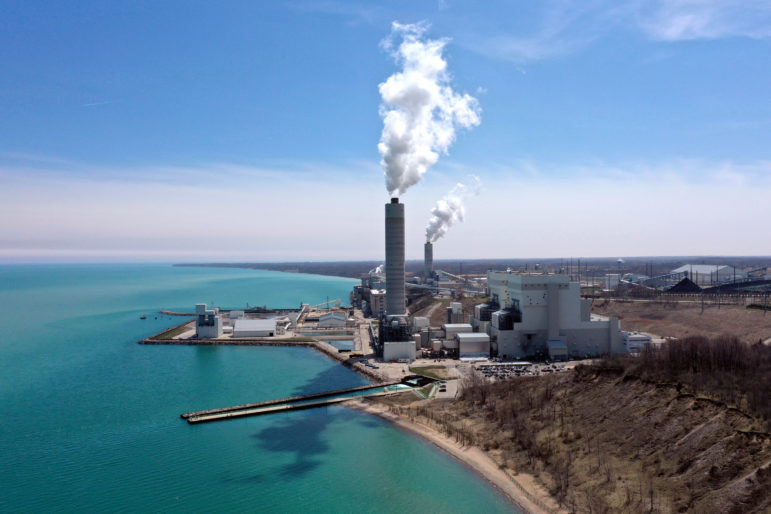We Energies, Alliant Closing Coal Plants
But customers could be paying off utilities' coal plant debt for years to come.
Wisconsin utility WEC Group announced to shareholders last month that its subsidiaries would phase out coal by 2032, three years earlier than previously planned.
We Energies’ Oak Creek plants will close in 2024 and 2025. Columbia Energy Center — the state’s largest coal plant, co-owned by WEC and Alliant — will close by 2026. Weston Unit 3 — co-owned with Dairyland Power Cooperative — will close by 2031.
Advocates applauded the news but said it only increases the urgency of making sure that ratepayers aren’t saddled with the costs of coal plants for years after they close. Under current policy, utilities can keep recouping their investments in coal plants — including in expensive pollution controls — and even earn a rate of return on those investments, after coal plants have ceased producing energy.
Advocates are calling for increased use of securitization, wherein a coal plant owner issues bonds to reduce the burden of debt after closure, similar to refinancing a mortgage. And they are arguing against the very premise that utilities are able to keep earning profits on coal plants that have closed.
Rate cases are proceeding before the state Public Service Commission for both We Energies and Alliant that include debate over the finances of closed coal plants.
“We need to look at more options for saving people money, whether refinancing through securitization, or even the prospect of disallowing any profit from those plants, which would be a bold step,” said Citizens Utility Board Executive Director Tom Content. “Why should utilities be profiting from something that is already a brownfield site? Given all the investments the commission has approved for utilities that are natural gas, solar, battery storage, they’re doing well financially. Customers deserve a break.”
Denying profits?
Alliant is allowed to reap a 10% profit on its investments, including after coal plants are closed, and We Energies is allowed a 9.8% profit.
Alliant’s Edgewater coal plant in Sheboygan will close by 2025. A Nov. 9 rate case hearing before the Public Service Commission included Alliant’s plans to keep charging ratepayers for its investments in the plant.
Content said that while the commission didn’t mandate the utility reduce costs to ratepayers, he was glad commissioners expressed frustration with Alliant for failing to consider ways to reduce the burden of the closed plant.
Alliant earlier reached a settlement with the Citizens Utility Board to use a method called levelization in recouping its investments for the Edgewater plant. This arrangement reduces the costs to ratepayers in the years right after the coal plant closes, but could increase what ratepayers fork out by $90 million total by 2045, CUB regulatory affairs director Corey Singletary said in testimony before the commission in September.
Singletary argued that once a coal plant like Alliant’s Edgewater is no longer “used and useful,” a utility should not be able to charge ratepayers for profits on the initial investment or installation of pollution controls. While such a policy could theoretically cause utilities to run coal plants even after they are not needed, Singletary said the commission could charge a company trying to do so with being “imprudent.”
“It’s important to consider that utility investors have been provided a return on Edgewater plant in service for years, returns that have reflected the risk of owning and operating a utility, including the risk that one day the utility’s investments may no longer be in the money,” Singletary testified.
He concluded that the commission could call for a “complete disallowance” of profits on closed coal plants, even though it did approve their construction in the first place.
In testimonies before the commission regarding both Alliant and We Energies, Singletary said the companies are treating securitization as the “floor” in reducing costs to customers for the retiring coal plant, when in reality the “floor” could be “zero” payments for the plant once it closes.
Expanding securitization
Currently, utilities are allowed though not required to use securitization to offset the costs of pollution control equipment. This measure was used to save ratepayers about $40 million regarding the 2018 closing of WEC’s Pleasant Prairie coal plant.
A 2004 law allows such securitization, but Pleasant Prairie is the only time that it has been invoked.
A bill introduced by Republican state Sens. Robert Cowles and Duey Stroebel in October would expand the potential use of securitization, or environmental trust bonds, as the bill (LRB 4441) phrases it, in part by expanding the definition of “environmental control” to actually describe a coal plant closure.
The bill would let the Public Service Commission order a company to use environmental trust bonds after closure, a power the commission doesn’t currently have.
Cowles also introduced a number of other bills demanding more transparency and ratepayer protections from the commission. The legislature will break for two months after Nov. 16, meaning the bills won’t likely move forward until 2024.
Cowles’ co-sponsorship memo for the securitization bill argues that commission decisions “such as the early closing of a power plant, often do not even come before the Commission prior to the closure of the facility, despite the fact that ratepayers will still be responsible for paying the outstanding debt on a facility which is not creating any benefits for consumers.”
We Energies example
The Citizens Utility Board charges that We Energies did not adequately consider alternatives to reduce the cost burden on customers around the Oak Creek plant’s closing.
The company in its filings modeled recovering Oak Creek costs over 16 years and over 25 years, and also over 25 years with securitization of $100 million in retrofit investments. The longer cost recovery could save ratepayers in the near term but actually cost them as much as $153 million extra over time, CUB’s analysis found.
CUB told the commission that We Energies should consider securitization of the full $407 million outstanding for Oak Creek. CUB argued the commission should also simply not allow the company to recover certain costs once the coal plant is closed.
The Wisconsin Industrial Energy Group, which represents 25 large industrial energy users, also testified to the commission criticizing We Energies’ plans for the Oak Creek debt. It said securitizing $100 million is “too little and the interest rates and servicing fees too great,” and recommended a more comprehensive securitization plan.
The utility had argued that state law only allows securitization of investments in pollution controls. But the industrial group’s expert Lane Kollen argued that the question is open to legal interpretation, and securitization on all outstanding costs could be sought.
Kollen also stressed that savings from securitization should be shared with customers, which is not required by Wisconsin law, and the utility’s profit on investments in the coal plant should be reduced after it is retired.
The industrial organization compared We Energies’ proposal to securitization plans by Duke Energy Progress and Kentucky Power Company regarding their own coal plants, and noted that those utilities were proposing much more advantageous situations for ratepayers.
“Given the unprecedented rate increases that [We Energies] customers are facing as they support the necessary and enormously expensive transition to clean energy, more than ever it would be reasonable for the commission to determine that customers should not bear the full cost of a decommissioned” Oak Creek plant, CUB’s testimony said.
Similar to the We Energies case, Singletary and Kollen both said in testimony that Alliant should consider securitization on the full $473 million in outstanding costs for the Edgewater plant. Singletary said this could result in $80 million savings for ratepayers.
Kollen charged that in its rate case filings, the company miscalculated possible savings from securitization, making it look less attractive than it would actually be.
Federal funds
The Inflation Reduction Act’s Energy Infrastructure Reinvestment Program could also provide relief around the costs of closed coal plants. The program provides low-interest loans if defunct energy infrastructure is retooled or repowered to meet clean energy goals. In all, the IRA created $250 billion worth of such loans.
Clean Wisconsin said in testimony before the commission that Alliant could tap the IRA program to refinance the Edgewater debt, then use those savings along with other IRA incentives to invest in 150 megawatts of solar and battery storage on the Edgewater site. That would help the utility invest in renewables without placing the burden on ratepayers. Clean Wisconsin’s analysis found leveraging IRA funds could save $168 million related to the coal plant retirement, compared to the planned levelization approach.
“These coal plants are already not economical to run, and when they have to compete against cheaper electricity from the wind they’ll run even less frequently and potentially accelerate their closure,” Clean Wisconsin energy and air manager Ciaran Gallagher told the Energy News Network.
An Alliant representative testified before the commission that they had previously discussed this idea with the Department of Energy, and were told the project would not be eligible. But such determinations could “change over time,” Clean Wisconsin’s testimony said, and the utility should revisit the possibility.
“To do any less would be squandering an opportunity to realize a win-win solution for the company and its customers, while ensuring Wisconsin benefits to the greatest extent possible from the Federal Government’s unprecedented investment in clean energy,” the testimony said.
“The Commission should ensure [Alliant] does everything possible to take full advantage of this and other recently authorized federal funding opportunities to make Wisconsin’s transition to clean energy more cost-effective for the utility’s customers.”
This article first appeared on Energy News Network and is republished here under a Creative Commons license.![]()





















WE Energies must pay 100% Securitization cost.
It’s been “pimping” consumers for Shareholders & CEOs.
State statutes allows Public Utilities. That would serve consumers.